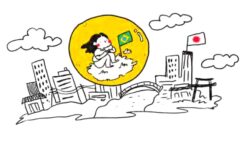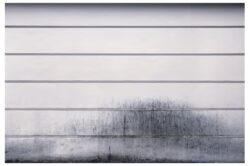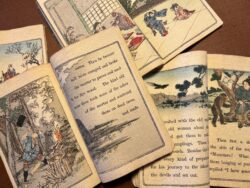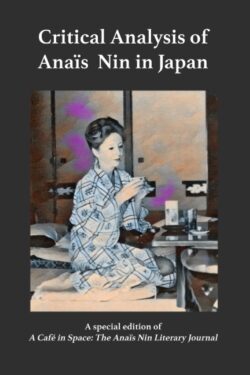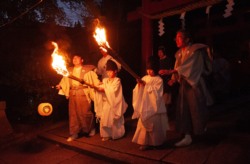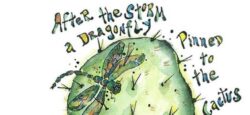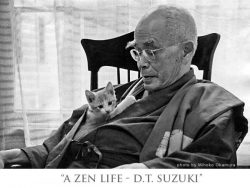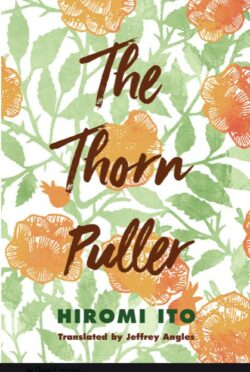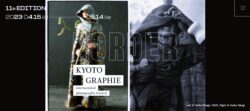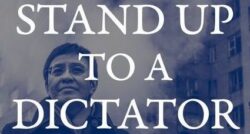The Great Fire of Kyoto, 1788: A Forgotten History
It was mid-afternoon on the last day of the month when fire broke out just east of the Kamo river and south of the small Donguri Bridge (south of Shijō). By 6pm flames had spread as far as Teramachi, a thoroughfare containing many temples. By midnight it was at the Shimogamo Shrine. At 2am the Dairi (today called the Gosho, or imperial palace) was threatened; shortly thereafter the main walled section of the shogunal compound, Nijō Castle, was alight. Rain fell, but it was not enough, and by morning 201 temples, 37 shrines, 36,797 common dwellings and a total of 1,424 city blocks in 20 separate locations were gone.
Read MoreCharcoal-inspired Sumi Artistry
The Kyoto-based artist known simply as Hakama uses sumi (charcoal) as his medium in creating innovative artworks with a subtle but impressive aesthetic imbued by direct use of natural materials transformed by fire.
His work was featured in KJ 107, ‘Fire & Kyoto.’
Read MoreKyoto Flame: sparking untold narratives in Kyoto
Charles Roche, long-term Kyoto resident, reminisces about The Flame, a unique monthly community-based storytelling event held at his hospitable Papa Jon’s Eatery. As figurative keeper of the flame for three years, Charles sparked a conflagration that lit up the local scene.
Read MoreMICHIKO AND THE SHUMISEN STONE
612 CE: This year a man emigrated from Baekje whose face and body were all flecked with white, perhaps having been infected with white ringworm. Disliking his extraordinary appearance, the people wished to cast him away on an island in the sea. But this man said, “If you dislike my spotted skin, you should not breed horses or cattle in this country which are spotted with white. Moreover, I have a small talent. I can make the figures of hills and mountains. If you kept me and made use of me, it would be to the advantage of the country. Why should you waste me by casting me away on an island of the sea?”
Read MoreKyotographie 2024, “Source”: Wellsprings of Creativity
For the past 13 years, co-directors Lucille Reyboz and Nakanishi Yusuke have invited the people of Kyoto – old, established families to tourists just passing through – to engage in a month-long jeu d’esprit inspired by their ecumenical embrace of all aspects of the photographic medium, from crude pinhole cameras to high-powered scientific instruments, and everything else in between.
Read MoreThe Japanese Diaspora in Japan
What does it mean to be Nikkei, a member of the Japanese diaspora? By being simultaneously Japanese and non-Japanese, Nikkei are forcing a re-evaluation of Japanese identity.
Japanese identity is complex and often oversimplified, its nuances underappreciated. Through interviews with Nikkei—particularly those who have returned to their ancestral homeland—I hope to shine a light on their experiences as outliers of Japanese identity, find common threads, and gain a deeper insight into the edges and unspoken essence of Japaneseness—what it means to be Japanese.
Read MoreWhite Lines
Horizontal lines on an earthen wall. Found on the outer walls of temples, some shrines, and the Imperial Palace, these lines indicate close historical ties to the Imperial family. Some temples have three or four lines, but the walls of monzeki jiin, where members of the Imperial family have served, are decorated with five.
Throughout the city of Kyoto, these lines are so ubiquitous as to go unnoticed by visitors and residents alike. For me, they have a mysterious beauty. Amidst all the classic scenes of Kyoto, I have found myself photographing these simple walls again and again. They are images which were literally painted by the weather.
Read MoreKagami: the Resonance of Ryuichi Sakamoto
Wearing a black suit and tortoiseshell glasses, he leans over a grand piano. Spotlit, his neatly cropped silver hair shines in the distance. Coming closer, I can see freckles on his pale face. He lifts his hands, lets them fall on the glossy keys, and begins ‘Before Long,’ the first of ten solo pieces he will play tonight. I can see the hammers of the Yamaha twitch.
How is this possible? The piano was not in the theater minutes earlier. And the musician—Ryuichi Sakamoto—passed away in March of 2023. Is he real? Is he present in this room? He can’t be, of course. But what does it mean to be present? To be real? The music, the sound waves, are alive. Is his spirit encoded in these frequencies and amplitudes?
Read MoreCultural Fluidity/First Experiences
“What is your oldest memory of something Japanese? What cultural product, news story, food, or schoolbook can you recall encountering as a child?”
To expand on the theme of cultural flow, we asked this question of all KJ 106 contributors and staff. Their answers, a small sampling of experiences, are microcosms of how Japanese culture has diffused around the globe and how this flow has changed over the last century. In many cases, those things remembered were only later discovered to be Japanese.
Reminiscing Ryoma
Ryōma was born in 1836 to a family that held the lowest rank in the samurai hierarchy, a title purchased by an ancestor who had made his name as a sake brewer. Despite these humble beginnings, Ryōma went on to become a master swordsman, and in recognition of his skill, his Tosa clan allowed him to continue his training in Edo. It was during his time in the old capital that American Naval Commodore Matthew Perry sailed to Japan to forcibly end the shogunate’s policy of national isolationism.
Read MoreSearching for the Self
“In Japan,” the French-born American novelist and diarist Anaïs Nin writes in her Diary in the summer of 1966, “I had a weeping fit. The sweetness, kindness, consideration touched me. For once in my life I felt I was treated as I always treated people.”
Read MoreInvitation to contribute – KJ 107 (Fire & Kyoto)
Fire transforms, renews and purifies. It is deeply embedded in the culture of Kyoto as a powerful destructive force, sacred agent and essential component of everyday life. The Repeated disastrous conflagrations over its long history have left an indelible mark on the psyche of the city, even today. Fire remains an integral part of spiritual and cultural practices in Kyoto, and the prevention of fire is an ever-present concern.
Read MoreTrigger of Light
I live in the spare, high desert of the American Southwest, a land of apparent and often illusory emptiness, a blinding bowl of light that triggers one to write with an economy of words. The eye follows winding arroyos, mouse tracks, and blowing seed. The breath gathers momentum along ridges, faults, and prehistoric waterlines. Fossils scatter at the feet, clay shards glisten after a sudden rain.
Read MoreA Zen Life: D.T. Suzuki
As a Nowhere Man, Suzuki was the perfect catalyst for an emerging Western strata of neo-transcendentalists, heirs to Emerson, Thoreau, Whitman, yet burdened with a psychological stigma as America gazed West across the Pacific and envisioned an Asia in ruins.
Read MoreThorns of Suffering
Hiromi Ito’s remarkable work, The Thorn Puller, takes readers on a pilgrimage across time, space, and literary genres. First serialized between 2006 and 2007 in the magazine Gunzō as Thorn Puller: New Tales of the Sugamo Jizō (Toge-nuki Jizō: Shin Sugamo Jizō engi), the work won the Hagiwara Sakutarō Prize in 2007 and the Murasaki Shikibu Prize in 2008 before appearing as a single volume published by Kōdansha in 2011.
Read MorePhotography Without Borders: Kyotographie 2023
One of the pleasures of KYOTOGRAPHIE has always been the opportunity to explore Kyoto spaces that are not normally open even to longtime residents, and to appreciate the imaginative ways in which the exhibitions have been staged in them. This year, the number of main venues has expanded to 15, while their geography has contracted, presumably to accommodate the influx of day trippers and international visitors. At the same time, the number of KG+ satellite exhibitions in far-flung locations around town has increased to 92, in addition to the 10 KG+ Select and 9 Special exhibitions.
Read MoreThe 72 Japanese micro-seasons
Ever since our ancestors gazed skywards or closely observed the wonders of the natural world around them, they saw patterns in cycles and found ways to recall them. Different cultures around the world have developed systems to mark the passage of time, and every calendar reveals something about how the people who created it related to the world around them. The ancient Japanese almanac of 72 micro-seasons provides a map of time that is a fascinating mixture of culture and nature.
Read MoreKyoto’s Suburban Rice-fields
As recently as the early 20th century, verdant and productive rice fields dominated the flat lands on the northern outskirts of Kyoto, squeezing small villages up against surrounding foothills. However, in post-war years this fertile farmland has been encroached on and overwhelmed by waves of suburbanization.
Read MoreThirty-One Views of Japan
This book, unique and extraordinary, is full of captivating accounts written by 31 people from all over the world who are living or have lived in Japan. It’s not about what brought them to the Land of the Rising Sun. It’s about the passions and interests that make them stay. “This is a book about the journey from simply living in Japan to actually calling Japan home.”
Read MoreResisting Democracy’s Death by a Thousand Cuts
Part memoir and part manifesto, How to Stand Up to a Dictator is Ressa’s look back at her early life in the Philippines and the United States, a chronicle of her personal rise through the news industry as one of the most respected broadcast journalists in Asia, and her forward-looking call to action to save democratic societies from dying by what she calls “a thousand cuts” of intimidation and injustice that add up over time. The dictator in question here is as much Big Tech as it is Big Brother.
Read MoreMeeting the Challenges of One’s Times
Toshi (1901-1995) is perhaps most famous for her anti-war activism and The Hiroshima Panels, a series of artworks on the aftermath of the atomic bombing, both of which she carried out in conjunction with her husband Maruki Iri. Given this legacy, it is all the more salient that in a late interview she called herself “a war criminal.” Toshi explained that during WWII she took commissions for children’s picture books glorifying the war. Though she did so to prevent from starving, she felt that this did not absolve her of her guilt. The Art of Persistence is about this tension between moral imperative and survival, not only during this particular time but throughout the whole of Toshi’s life.
Read More





